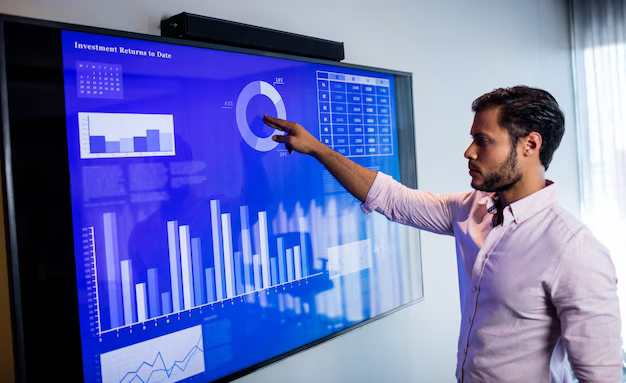Rendering raw numbers and information into easy-to-digest visual content is the magic of data visualization. It’s an amalgamation of art and analytics, presenting statistical information in the form of informative designs. These graphic representations foster better comprehension, allowing users to absorb, digest, and appreciate the significance of the data at a glance.
In the digital age, interactive data visualization takes this concept a notch higher. It doesn’t just show information—it allows users to engage with it. Users can manipulate the data points to analyze and delve deeper into the presented information. This interactivity piques curiosity and retains users’ attention far longer than static visuals.
The thought of incorporating interactivity into your visual content might seem intimidating. Thankfully, advancements in technology have made this process considerably less challenging. Leading web creation platforms now offer a vast array of plug-ins and readily available design elements, all designed to streamline the process of creating interactive data visualizations.
How can Data Visualization be Enhanced with Interactivity?
Traditional graphs and charts serve their purpose in displaying data in an understandable way. However, they typically present the information in a static, one-dimensional manner, and are often swiftly bypassed by viewers in the constant scroll for more engaging content. This is where the power of interactivity spices things up. By adding an engaging layer to the visuals, viewers are not just passive recipients, but active participants in their data exploration journey.
Interactivity invites the audience to interact with the data, stirring their curiosity and inviting them to delve deeper. The audience isn’t just looking at the data; they are given the opportunity to manipulate it, to view it from different angles, and to uncover more layers. This dynamic participation enables a richer understanding of the data being presented.
Consider these advantages that interactivity brings to data visualization:
- Engagement: Interactivity compels the viewer to spend more time examining and understanding the data;
- Exploration: Through user-initiated actions, additional details and data layers can be revealed;
- Understanding: By enabling viewers to manipulate and interact with the data, they gain more insight and relevance from the information;
- Retention: The interactive experience makes it more likely for the information to stick in viewers’ minds.
The process of incorporating interactivity into your data visualization might seem intimidating at first glance. Thankfully, modern web development platforms have simplified this process with a wealth of plugins and design elements tailored for these interactive features. These resources make it possible even for non-programmers to create engaging, interactive data visualizations.
How can User Engagement be Enhanced with Interactive Data Visualization Techniques?
Interactive data visualization provides an ocean of opportunities for making data more engaging. However, the effectiveness of a visualization depends largely on the techniques used in its creation. Below are some popular techniques widely used in modern web design that can elevate the interactivity of your data visualization.
- Motion Graphics: Motion graphics including animated pie charts, line graphs, infographics, etc., can grab the viewer’s attention and zero it in on the data. Movement adds an element of surprise and breaks the monotony of static visuals;
- Ticking Counters: The sight of numbers ratcheting upwards can be surprisingly engaging. It not only conveys the escalating magnitude of data but also creates a sense of anticipation for the viewer;
- Interactive Buttons: Buttons or other user interface elements can take the viewer through different sections of your data. They can be used to navigate through information or reveal additional layers of data, providing a greater depth of interaction;
- Hover Effects: These are typically used to momentarily reveal or conceal information as the cursor moves over a certain area. Hover effects can be used to show and hide numbers, texts, or visuals, making the data exploration a more engaging process;
- 3D Visuals: Inspired by augmented reality, 3D elements such as topographic maps and other three-dimensional objects provide a more immersive user experience. They bring data to life, making it more tangible and navigable;
- Scroll-Triggered Animations: These are animations triggered by the user’s scroll, adding an element of dynamism to graphs, numbers, charts, and text. Scroll-triggered animations can make the data pop out from the rest of the content, enhancing its visibility and engagement.

10 Noteworthy Interactive Data Visualization Examples
Data, when creatively presented, can be a captivating source of information. Let’s delve into a range of interactive data visualization examples that illustrate how you can breathe life into your data and make it more engaging.
Pine Cove Camp: Adding a Personal Touch to Data
Pine Cove Camp’s use of Vev to present a vivid portrait of their camping experience is impressive. Through an amalgamation of captivating photos, testimonials, and a vibrant layout, they offer a peek into the life of their camp attendees. Inclusive of an interactive dropdown, their infographic effectively presents their scholarship beneficiaries, making the data personal and relatable.
Navigating the Tualatin River Watershed: A Journey through an Ecosystem
The Tualatin River Watershed in Oregon is presented as an interactive data visualization that takes viewers on a journey through its complex ecosystem. The design employs a three-dimensional navigation method that lets you explore the interconnected aspects of its ecology. The result is a rich, immersive experience that not only showcases the watershed’s stunning landscapes but also educates visitors about its delicate ecological balance.
The Human Rights House Foundation: Employing Visual Effects for Impact
The 2021 report from The Human Rights House is an example of effectively using visual effects to present data. Focusing on the Russia-Ukraine conflict, the report uses Vev to present text-heavy information, supported by parallax scrolling and animated data visualizations. The usage of animated number counters brings their accomplishments to life.
The Pudding: Wine Data Modeling
The Pudding offers an intriguing look at how data modeling can predict wine quality. Using easily-understandable data sets, this interactive visualization demystifies the concept of data science and provides insights into predictive modeling. It’s an excellent example of how interactive data visualization can make complex processes accessible.
Service Now: Highlighting Sustainability
Service Now’s sustainability report is a study in how interactive visualizations can be both beautiful and informative. Using Vev, the report presents a visually stunning overview of the importance of corporate sustainability efforts. Scroll-triggered effects like parallax, fade-ins, and animated data visualization examples enhance the user experience, making the data presentation engaging and memorable.
Information is Beautiful: Major Data Breaches and Hacks
David McCandless’ website, Information is Beautiful, is a treasure trove of innovative interactive data visualizations. One notable example shows major data breaches on various platforms. Hovering over the representation reveals details of the breaches, providing in-depth insights while keeping the user engaged.
Vev Year In Review 2022: Celebrating Achievements
Vev’s Annual Report for 2022 expertly balances the presentation of comprehensive data with visual engagement. Animated numbers breathe life into user statistics, while a 3D globe highlights the global team. The overall effect is an engaging review that keeps the reader captivated.
World Wildlife Fund: Showcasing Biodiversity
The World Wildlife Fund’s Canadian chapter uses Vev to create an expansive and immersive interface that underscores the importance of biodiversity. A combination of beautiful wildlife imagery, horizontally scrolled content, and upward moving number counters effectively communicate crucial data related to their conservation efforts.
QuintoAndar Housing Census: Demographics and Housing
The QuintoAndar Housing Census presents an extensive array of data related to the demographics of Brazil and their relationship with housing. Effective scroll-triggered animations bring to life a comprehensive collection of data, keeping the reader engaged and informed.
The Tobacco Atlas: Health Effects of Smoking
Despite widespread awareness about the ill effects of smoking, tobacco consumption remains prevalent worldwide. The Tobacco Atlas compiles statistics about smoking and its global effects into a comprehensive interactive visualization that no viewer can overlook.
Unique Conclusion
As we’ve seen, interactive data visualization is more than an innovative approach to present data—it’s a transformative tool that enhances comprehension, engagement, and retention. By employing interactivity, motion graphics, augmented reality, machine learning, and other advanced techniques, data visualization breaks free from its static bounds and steps into a realm of active user engagement. Whether deployed in corporate reports, academic research, or social awareness campaigns, these vibrant, dynamic visualizations embody the ultimate goal of data communication—to inform, engage, and inspire.

